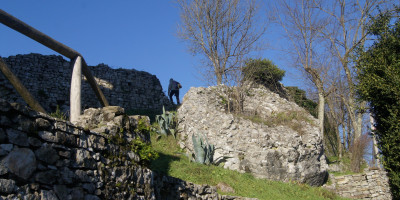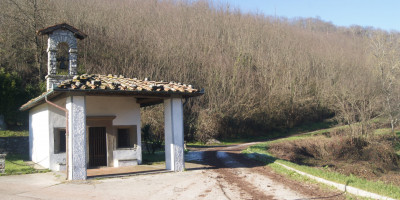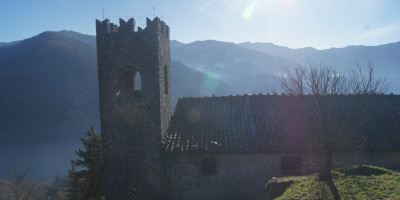Rocca di Mozzano
Origini
Il borgo della Rocca ha una specifica origine medievale come luogo fortificato a presidio del territorio della valle del Serchio. Come altre “rocche” sorge in un luogo elevato e panoramico, peculiare delle prime fasi dell’incastellamento del XI secolo. Dall’XI secolo il territorio della Rocca finì nell’influenza della famiglia feudale di origine longobarda dei Suffredinghi, attestata dal IX secolo, assieme a molti altri territori della Garfagnana. Le prima attestazione della Rocca come Castello di Mozzano è in una carta del 1027 conservata nell’Archivio Diocesano di Lucca. Qui si elencano i beni della famiglia dei Suffredinghi: la Rocca appartiene loro assieme al castello del Monte Bargiglio (presso la vicina frazione della Cune). In un contratto del 1122 emerge infine la prima attestazione sicura come Rocha de Mozano. Da qui si ricava anche il nome del signore suffredingo della Rocca: Ildebrando di Sigifredo (1038-1072) nipote di Gherardo II, vescovo di Lucca nel 991.
Le guerre tra Lucca e Pisa del XII secolo
Nelle guerra tra Lucca e Pisa i Suffredinghi si schierarono a fianco dei pisani contro l’avanzata del comune lucchese. A partire dal 1170 i lucchesi ingaggiarono infatti una serie di guerre per impadronirsi della valle del Serchio e della Versilia. Nel 1171 i lucchesi si impadronirono della Rocca di Mozzano, abbandonata temporaneamente dai Suffredinghi rifugiati nel castello di Fornoli (Bagni di Lucca). Da qui si batterono contro la guarnigione pisana che giungeva dalla Garfagnana. Intimorito dalle vittorie di Lucca in Garfagnana, Raimundo di Guglielmo signore della Rocca di Mozzano, si alleò dapprima con la città lucchese ed inseguito attirò dalla sua parte, dietro versamento di denaro, gli altri nobili alleati sino ad allora con Pisa. Così dal 1173 i Suffredinghi finirono per stringere un patto militare con Lucca, rinnovato nel 1181, anno della pace fra Lucca e Pisa. Nel 1185 l’imperatore Federico I Barbarossa obbligò il comune di Lucca a riedificare i castelli distrutti durante la guerra con Pisa, fra cui anche quelli di Anchiano e Cune (Bargiglio). Non essendo citato quello della Rocca si suppone che questo non avesse subito danni. La casata nel 1209 rinnovò la fedeltà a Lucca.
Le guerre tra Lucca,Pisa e Firenze del XIII secolo
Nel 1220 Lucca, alleata con Firenze, fu nuovamente in guerra contro Pisa. Le vecchie signorie feudali della Valle del Serchio, nonostante il giuramento di fedeltà, si schierarono ancora con i pisani. Per questo motivo nel 1225 i lucchesi espugnarono dapprima il castello di Anchiano, dove risiedeva un ramo della famiglia longobarda, e nel 1227 sottomisero il castello della Rocca catturando gli ultimi castellani Suffredinghi. I discendenti dell’antica casata longobarda ottennero infine nel 1248 la cittadinanza lucchese, sebbene interdetti alla vita pubblica.
La Repubblica di Lucca
Dopo le vittorie di Lucca nel contado la media valle del Serchio passò alla nascente Repubblica di Lucca e la Rocca passò nel 1272 alla vicaria di Coreglia. Nel 1355 la Rocca insieme a tutta la vicaria entrò a far parte della contea di Coreglia, istituita dall’imperatore Carlo IV, per poi finire nel 1562 sotto la giurisdizione della vicaria di Borgo a Mozzano divenuta poi capoluogo comunale. Nel 1586 la Rocca si dota del suo stato comunitario, perfezionato poi nel 1638.
Ultimo secolo ed epoca moderna
Il borgo della Rocca contava 205 abitanti nel 1832.
Negli anni sessanta del Novecento nei pressi del paese della Rocca fu rinvenuto un fondo di capanna databile tra il III e il II secolo a.C. con resti ceramici di tipo ligure. Nel 1983 sono state inoltre ritrovate alcuni frammenti di anfore greco-italiche sul versante tra il borgo della Rocca e Piano della Rocca, sulla valle del Serchio.







